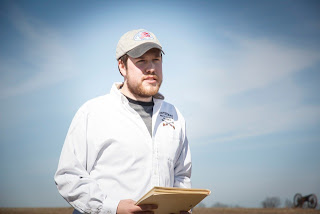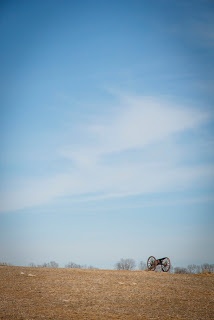Earlier this month, we looked at the terrain of the Mumma farm from a panorama view. Today, we will look at the Roulette farm; primarily, we will be focusing on the approach of French and Richardon's divisions in their assault on the Sunken Road. For those who didn't read the previous post, please check it out at the link above. It goes hand in hand with today's post.
This panorama shot shows the ground over which men of William French's and Israel Richardson's divisions advanced on the morning of September 17, 1862. These two divisions had been separated from John Sedgwick's division of the Second Corps due to terrain, orders, and confusion (this is discussed more in the previous post). On the far left of the photograph, the Observation Tower on the Sunken Road can be seen. On the far right, there is the Roulette Farm. This picture was taken from one of the highest ridges on the ground over which these Federal soldiers advanced. They moved across this ground from right to left in this photograph.
In this version of the Ezra Carman map showing troop movements from 9 am to 9:30 am, several features are highlighted. First, the spot where the panorama was taken is noted by an orange star. The observation tower is indicated by a tall red pyramid, helping to show where the left edge of the image is located. The Roulette farm, on the right of the panorama, is circled in red. The location of the Visitor Center is circled in yellow, and the Reel Ridge in the far distance of the panorama is highlighted in light blue. Additionally, the trees along the Roulette farm lane, visible in the center of the panorama photograph, are highlighted by a green line in the map above. I thought these enhancements would help interpret the map and the photos together, especially for those who aren't terribly familiar with the terrain and location.
The reason why this photograph is so telling is it shows something vitally important about the Sunken Road attack. This terrain, like much of Antietam, is an ocean of hills, ridges, swales, and depressions. This terrain was one major reason why the killing and slaughter was so great that day. From this position, only parts of the Sunken Road can be seen, making it a hidden trench of sorts. However, Federal soldiers would have been open to artillery fire from the Piper Farm behind the Sunken Road and, more importantly, from the Reel Ridge. While the Piper Farm is hidden from view, the Reel Ridge is just under one mile away. It was covered with Confederate artillery and able to blast Union soldiers advancing on the Sunken Road. While we often discuss the view Confederate soldiers in the road had of advancing Federals, we often forget that those Federals were exposed to artillery fire throughout the assault.
Essentially, the views for advancing soldiers were changing with every step they took. While this may seem an obvious point, it is much more relevant when considering that the lines of sight are changing, affecting the vulnerability of attacking soldiers to rifle and artillery fire.
Here are a few more specific shots of the terrain:
This picture, taken from behind the Roulette Farm, is looking toward the Sunken Road and the Observation Tower, visible in the distance. While the trees in the foreground were not present in 1862, they don't take away from what the image tells us; from this position, seeing and understanding the strength of Confederates in the road was a near impossibility due to the terrain.
This image was taken from the same vantage point as the panorama photograph, and is looking toward the Roullette farm (the right side of the panorama)
This image was also taken at the same point as the panorama. It is looking toward the hill on which the visitor center currently sits.
This image, taken from the spot of Graham's battery, is near the site of the previous two pictures. It shows how close they were to the Observation Tower.
Image of the view Graham's battery would have had in responding to Confederate fire on the Piper Farm (invisible from this spot due to terrain) and the barely visible Reel Ridge in the distance.
A better image showing that most of the Sunken Road is barely visible from this spot. In the distance is Reel Ridge, which was covered by Confederate artillery pieces firing into the ranks of oncoming Union soldiers in French's and Richardson's divisions.
























